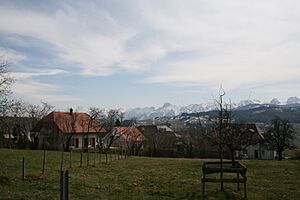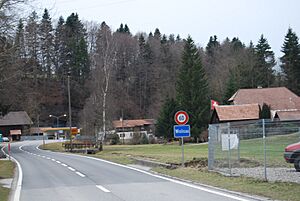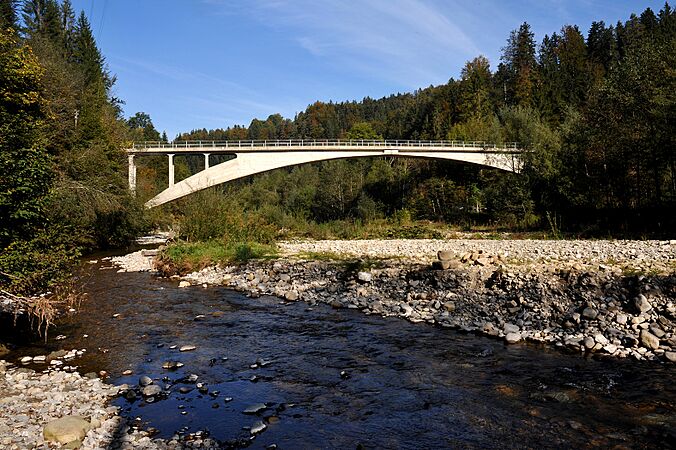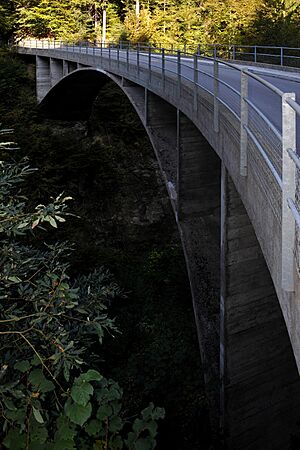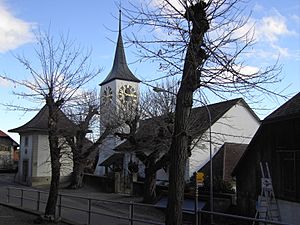Rüeggisberg facts for kids
Quick facts for kids
Rüeggisberg
|
||
|---|---|---|
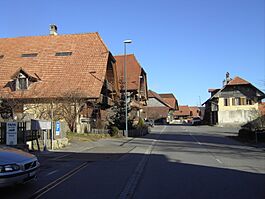 |
||
|
||
| Country | Switzerland | |
| Canton | Bern | |
| District | Bern-Mittelland | |
| Area | ||
| • Total | 35.81 km2 (13.83 sq mi) | |
| Elevation | 930 m (3,050 ft) | |
| Population
(Dec 2020 )
|
||
| • Total | 1,765 | |
| • Density | 49.288/km2 (127.66/sq mi) | |
| Postal code |
3088
|
|
| Localities | Rüeggisberg (Mättiwil, Tromwil); Bütschel (Oberbütschel, Niederbütschel, Gschneit, Bungerten); Fultigen (Hinterfultigen, Vorderfultigen); Helgisried-Rohrbach (Helgisried, Rohrbach, Wiler, Schwanden, Brügglen, Schwand) | |
| Surrounded by | Blumenstein, Därstetten, Kaufdorf, Niedermuhlern, Oberbalm, Riggisberg, Rümligen, Rüschegg, Rüti bei Riggisberg, Toffen, Wahlern | |
Rüeggisberg is a small town, also called a municipality, located in the Bern-Mittelland area in the region of Bern in Switzerland.
Contents
History of Rüeggisberg
Rüeggisberg was first mentioned in old writings in 1075. Back then, it was called mons Richeri. Later, in 1224, it was known as Ruogersperg.
The oldest sign of people living here is an old Roman road. This road probably went through Rüeggisberg. It connected the Roman city of Aventicum with the Thun lake area.
During the Middle Ages, there were three old forts or castles in the area. These were Büffelhölzli, Ramsburg, and Schlosschäle. We don't have many records about them. Only a few old items have been found.
The Priory of Rüeggisberg
The Rüeggisberg Priory was a special religious house. It was built between 1072 and 1076. Lütold of Rümligen started it. He gave the land to Cluny Abbey. This made it the first Cluniac house in the German-speaking world.
The first buildings were made by Cuno of Siegburg and Ulrich of Zell. The main church was built from about 1100 to 1185. It was made in the Romanesque style. Today, only parts of the north transept and the central tower remain.
Over time, the Priory became less powerful. In 1484, it joined the new college of the Augustinian Canons of Bern Minster. By 1532, much of the town was destroyed by a fire. The Priory was then left empty. The church closed in 1541 during the Reformation. Parts of it were taken apart to use the stones for other buildings.
Village Life and Changes
The village church of St. Martin was also built a long time ago. It was expanded many times. This happened after a fire in 1532 and again in later centuries.
For a long time, the villagers were like servants to the Priory. But as the Priory lost power, the villagers gained more rights. By 1500, the village became completely independent.
People in Rüeggisberg traditionally grew crops. They farmed in the valleys and on high mountain meadows. In the 1800s, they started focusing more on raising cattle. They made milk and cheese in the mountain meadows during spring and summer.
In 1803, Rüeggisberg became part of the Seftigen District. Between 1850 and 1980, the number of people living here went down. Many moved away to other parts of Switzerland or to bigger cities. This changed around 1975. Better roads and a bus to Bern made it easier for people to travel for work.
Today, about half of the jobs in Rüeggisberg are in farming. There are five primary schools spread out in the area. However, older students go to secondary school in Riggisberg.
The Rossgraben and Schwandbach bridges are important landmarks. They were built in 1932 and 1933 by Robert Maillart. These bridges are now considered very important Swiss heritage sites.
Geography of Rüeggisberg
Rüeggisberg covers an area of about 35.7 square kilometers (13.8 square miles). A large part of this land, about 64.2%, is used for farming. Forests cover about 29.5% of the area.
About 4.3% of the land has buildings or roads. A small part, 0.8%, is rivers or lakes. The remaining 1.0% is land that cannot be used for farming or building.
Most of the forested land is dense forest. Some areas have orchards or small groups of trees. For farming, about 13.1% is used for crops. A large part, 43.0%, is used for pastures where animals graze. Some land is used for fruit trees or grapevines. About 6.9% is used for high mountain pastures. All the water in the town flows in rivers or streams.
The town is located on a flat area. This area is on the southern side of the Längenberg mountain. Rüeggisberg includes the main village and smaller communities called hamlets. These include Oberbütschel, Niederbütschel, Vorderfultigen, Hinterfultigen, and Helgisried-Rohrbach. It also has some mountain meadows like Gantrisch and Nünenenfluh. Many scattered farmhouses are also part of the municipality.
In 2010, Rüeggisberg became part of the new Bern-Mittelland administrative district.
Coat of Arms
The blazon of the town's coat of arms shows a red shield. On it, there is a golden star. This star is placed between two green fir trees. The trees grow from three green hills at the bottom.
Population and People
Rüeggisberg has a population of about 1,846 people (as of December 2012). A small part of the population, about 2.6%, are people from other countries.
Between 2010 and 2012, the population slightly decreased. This was mostly because more people moved away than moved in.
Most people in Rüeggisberg speak German. About 97.6% of the population uses German as their main language. Albanian is the second most common language. French is the third.
In 2008, about 49.5% of the population was male and 50.5% was female. Most people living in Rüeggisberg were born either in the town itself or in the same canton of Bern.
In 2012, children and teenagers (up to 19 years old) made up about 20.6% of the population. Adults (20-64 years old) made up 60.1%. Older people (over 64 years old) made up 19.3%.
The number of people living in Rüeggisberg has changed over time:

Important Heritage Sites
Several places in Rüeggisberg are listed as very important Swiss heritage sites. These include the Rossgrabenbrücke (a bridge shared with Wahlern), the old ruins of the Cluniac Rüeggisberg Priory Church, and the Schwandbachbrücke (another bridge). The entire village of Rüeggisberg and the hamlets of Oberbütschel and Schwanden are also part of the Inventory of Swiss Heritage Sites.
The Rüeggisberg Priory was founded between 1072 and 1076. It was a very important monastery in Switzerland during the Middle Ages. However, it declined later on. In 1541, the church was closed during the Reformation. The old buildings were then used as a source of building stones.
-
Ruins of the former Cluniac Rüeggisberg Priory Church
Economy and Jobs
In 2011, Rüeggisberg had a low unemployment rate of 1.12%. There were 677 people working in the town.
Many people work in the primary economic sector, which includes farming. About 349 people worked in this area. The secondary sector (like manufacturing and construction) employed 99 people. The tertiary sector (services like shops, hotels, and healthcare) employed 229 people.
In 2008, there were 464 full-time jobs. Most of these, 239, were in agriculture. In the secondary sector, 40 jobs were in manufacturing and 59 were in construction. In the service sector, jobs included sales, transportation, hotels, education, and healthcare.
Many people who live in Rüeggisberg travel to other towns for work. In 2000, 566 people commuted away from the town for their jobs. About 100 people came into Rüeggisberg to work. Most people who work in Rüeggisberg also live there. About 11.6% of workers used public transport. A larger number, 53.7%, used a private car to get to work.
Religion
Based on a 2000 survey, most people in Rüeggisberg, about 80.6%, belonged to the Swiss Reformed Church. About 3.0% were Roman Catholic. A smaller number of people belonged to other Christian churches. Some people were Muslim, Buddhist, or Hindu. About 5.72% of the population did not belong to any church.
Education
In Rüeggisberg, about 53.6% of adults have finished high school. About 14% have gone on to higher education, like a university.
The school system in Bern canton starts with one year of optional Kindergarten. After that, students go to six years of Primary school. Then, there are three years of lower Secondary school. In secondary school, students are grouped by their abilities. After secondary school, students can continue their education or start an apprenticeship to learn a trade.
During the 2011–12 school year, 154 students attended schools in Rüeggisberg. There were 26 students in kindergarten classes. In primary school, there were 102 students. For lower secondary school, there were 26 students.
In 2000, most students (213) lived and went to school in Rüeggisberg. Some students (26) came from other towns. Also, 80 students from Rüeggisberg went to schools outside the town.
See also
 In Spanish: Rüeggisberg para niños
In Spanish: Rüeggisberg para niños








